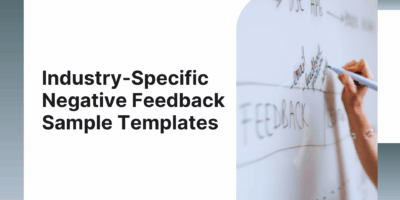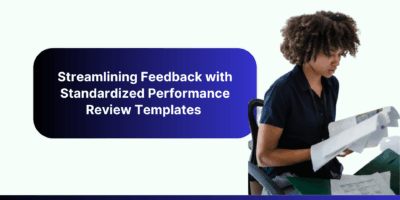
What is a Staff Appraisal?
Most employees and managers dread appraisals, yet nearly every organization still uses them. Is it just a corporate tradition, or do they deliver real value?


Founder & CEO of Wish For Yellow
In recent years, there has been a dramatic shift towards remote and hybrid working arrangements, with many employees demonstrating their ability to maintain productivity outside of the traditional office environment. However, this shift has also given rise to productivity theater and a new phenomenon: productivity paranoia.
Employers, unsure of how to measure productivity in a hybrid environment, are resorting to tactics such as tracking software and increased monitoring, which can lead to a culture of suspicion and anxiety.
On the other hand, there is also the danger of productivity theater, where employees may feel pressured to put on a display of productivity to prove their worth in a remote or hybrid setting.
As we navigate this new world of work, it’s important to strike a balance between trust and accountability and recognize that productivity is not always measured by hours spent “doing work.”
In this article, we’ll explore the impact of productivity paranoia and productivity theater on the modern workforce.
Productivity paranoia refers to the gap between employee and employer perceptions of productivity. The term was coined following companies’ increased productivity concern in the age of hybrid work.
According to a Microsoft survey of 20,000 people across 11 countries, 87% of employees report being productive at work. However, a staggering 85% of senior leaders say that the shift to hybrid work has made it challenging to have full confidence that employees are being productive.
With hybrid work, managers and leaders are less capable of seeing which team members are showing up and what they are producing on a daily basis.
Hybrid managers are more prone to express their difficulties in having faith in their employees to perform their best work compared to in-person managers (49% vs. 36%). They are also more likely to state that they have a limited view of their employees’ work (54% vs. 38%).
So, how can the gap between employee and employer perceptions of productivity in a hybrid work environment be bridged?
It starts with acknowledging the limitations of traditional productivity metrics and embracing more holistic approaches to measuring success. This means focusing on outcomes rather than inputs, trusting employees to manage their own time and deliverables, and providing the necessary tools and resources to facilitate productivity.

Productivity theater is the practice of creating the appearance of productivity without achieving anything significant. Employees may feel the need to look busy, even if they are not doing any meaningful work.
This is another phenomenon that has emerged in response to the pressure to be productive.
As such, productivity theater can take many forms, including attending optional meetings, spending time on unimportant tasks, or creating unnecessary complex reports.
The behavior stems from the fear of being perceived as unproductive or, even worse, being laid off and is reinforced by the outdated notion that business equals productivity.

Business, by definition, means to engage in activities and tasks to appear occupied and may not always result in a valuable outcome.
It usually represents jumping from one task to another, often without a clear direction. The focus here is on the number of assignments completed rather than their quality or impact. While it might create the appearance of productivity, busyness can sometimes lead to inefficiency, stress, and a lack of significant accomplishments.
Productivity, on the other hand, is a focused effort to create the best result. It involves carefully selecting and prioritizing tasks based on their importance and alignment with goals.
Unfortunately, managers and executives often perpetuate productivity theater, prioritizing appearances over results.
Both in-office and in the absence of physical supervision, employees often resort to demonstrating their busyness through constant communication and online presence, even when there is no real work to be done.
This has further clouded the distinction between being busy and being productive, emphasizing the problem with productivity paranoia and the vicious cycle it creates in the workplace.
While productivity paranoia may lead to increased productivity in the short term, it can be detrimental to the success of the organization.
Think about it: Leaders are worried that their employees aren’t being productive, while employees are constantly under pressure to perform and are even experiencing burnout.
Pressure can lead to burnout, and employees who are constantly under pressure to perform may experience high levels of stress. More than half (54%) of knowledge workers reported they feel pressure to show they are online at certain times of the day.
According to a study by the American Psychological Association, employees who feel the need to be “always on” and connected to their work through technology are more likely to experience burnout.
Knowledge work has an inherent cycle of activity and rest, and our brains require quiet moments and idleness for creativity to flourish. When employees are always “on,” it can stifle their ability to generate new ideas and produce high-quality work.
Furthermore, managers are overwhelming employees with meetings, leading to overlapping meetings and high levels of multitasking, which only adds to worker stress.
Since the beginning of the pandemic, the average Microsoft Teams user globally has witnessed a surge of 153% in the number of weekly meetings. As this trend shows no sign of reversing, it seems likely that this peak may become the new norm.
The shift to hybrid working aligns with employee preferences, with 60% of remote-capable US employees wanting a long-term hybrid arrangement. However, this starkly contrasts with managers’ preferences – as much as 72% of supervisors prefer their staff to work exclusively from the office.
Needless to say, this disparity in preferences may have serious implications for employees and their careers.
Working from home may impact their career prospects if managers perceive them as less hardworking than their peers who have returned to the office. A recent SHRM survey revealed that 67% of supervisors and managers consider remote workers to be more dispensable than on-site employees.
Furthermore, most supervisors (62%) believe remote work hinders employee career progression.
These attitudes suggest a lack of appreciation for the benefits of remote work and may contribute to an office culture that undervalues the work of remote workers. Despite the rise in remote working, managers are still looking for old and outdated visual cues to assess productivity.

Many companies have turned to use Bossware, or electronic monitoring, as a response to this problem, but is it the right approach?
Bossware or electronic monitoring can be used to monitor:
While 61% of UK employees are comfortable with their employers monitoring them, they only do so if they can see the data. In other words, most employees are receptive to the idea of HR teams utilizing more advanced analytics, provided that the process remains transparent and that they have some level of control.
While there are now various ways to monitor workers, more open and less invasive methods are likely to lead to more positive attitudes from workers.
Another problem with productivity paranoia is that it can create an atmosphere of mistrust. In this new world of work, organizations must continue to consider the psychological component of work.
Employees may feel like they are being constantly monitored or that their every move is being scrutinized. This can lead to a lack of autonomy and a feeling of being undervalued, which can lead to decreased job satisfaction and employee turnover.
The use of an outcome-based method, such as employee recognition software, employee incentive programs, and employee rewards platforms, is more suitable for knowledge work.
Ultimately, organizations need to shift their focus from time-based metrics to results-driven metrics if they want to improve productivity and reduce burnout.
Productivity theater is a pervasive issue in today’s workplaces. It’s a culture that values optics over outcomes, where looking busy is praised more than achieving anything meaningful.
This mindset can lead to a toxic work environment, with employees feeling frustrated, burned out, and undervalued.
Remote workers, in particular, are prone to digital presenteeism. It involves using “mouse movers” to keep the screen from going into sleep mode, responding to emails during strategically chosen hours, or creating overly complex reports that aren’t useful, and other actions designed to appear busy and productive.
Unfortunately, this superficial productivity adds up to a considerable amount of time wasted on a daily basis. In particular, digital presenteeism can consume up to 67 minutes of a remote worker’s day.
The problem with productivity theater is that it often leads to wasted time and resources. When employees are engaged in activities that aren’t contributing to the bottom line, it can take away from the time and energy they could spend on more meaningful work.
Meetings, emails, and brainstorming sessions that do not lead to tangible outcomes can also distract employees from more critical tasks and lead to missed opportunities. It can also lead to a lack of motivation among workers, as they are not being challenged or given meaningful work.
Productivity theater can create a toxic work environment, where employees feel like they are competing with each other rather than working as a team. It can also lead to a sense of distrust and cynicism, as employees feel like they are being judged on their appearance of productivity rather than their actual contributions.
The world is buzzing with talk of workplace trends. From “Quiet Quitting” to “Productivity Paranoia,” it seems like there is a new term being thrown around every week. While Quiet Firing and Productivity Paranoia represent long-standing issues in the workplace, recent events have brought them to the forefront of discussion.
For instance, in response to economic downturns, leaders are showing increased skepticism towards remote work. Workers at Goldman Sachs had to return to the office, Elon Musk rescinded Twitter’s work-from-home policy after acquiring the company, and Disney’s CEO Bob Iger reportedly expressed concerns about the remote model.
Undeniably, this heightened scrutiny from leaders is fueled by fears that workers are less productive while working remotely.
However, it raises the question: are these concerns well-founded?
Recent surveys by Mercer and HR firms reveal that productivity has remained the same or even increased since the pandemic started, even with employees working remotely. In fact, employees working from home tend to work an additional 48.5 minutes per day, leading to a 13% increase in productivity.
Of course, managing performance from afar can be formidable, and remote work presents unique challenges when it comes to monitoring employee activities and workloads. Micromanaging and electronic monitoring isn’t the answer, as one recent meta-analysis shows that they don’t improve worker performance and can actually increase worker stress.
Instead, employers should realize that despite being the latest buzzwords, overwork, burnout, and mismatched priorities as direct consequences of productivity theater and paranoia go beyond workplace trends. They reflect broader issues, such as the growing work-life disbalance of employees, their overall well-being, and poor organizational practices, stating an urgency of being correctly addressed.
|
Productivity Paranoia |
Productivity Theater |
|
Involves an excessive focus on measuring and monitoring employee activity to ensure they are being productive. |
Involves putting on a show of busyness to give the appearance of productivity without accomplishing meaningful work. |
|
Can create a culture of suspicion and anxiety among employees, leading to decreased morale and burnout. |
Can lead to a lack of accountability and a focus on quantity over quality. |
|
Often driven by a lack of trust between managers and employees, or a fear of decreased productivity in a hybrid work environment. |
Often driven by a desire to appear productive or a fear of being perceived as unproductive in a hybrid work environment. |
|
Can lead to micromanagement, which can decrease employee autonomy and creativity. |
Can result in employees feeling unfulfilled and dissatisfied with their work, leading to decreased engagement and productivity. |
|
Can be counterproductive, as it distracts from actual work and decreases morale. |
Can be counterproductive, as it leads to a lack of focus on the most important tasks and goals. |
Although they oppose each other, productivity paranoia and productivity theater are intricately linked.
When employers enforce their lack of trust and performance paranoia, workers might find a coping mechanism in productivity theater. In fear of not doing enough, employees can engage in superficial tasks to give the illusion of being productive, creating a cycle of unproductivity.
However, this theater of productivity comes at a cost.
The pressure to appear busy can lead to burnout, stress, and a decrease in the quality of work produced.
Employers must find a more balanced and sustainable approach to measuring productivity and break the cycle. Doing that requires stepping away from current metrics and accepting a more human-centric approach that recognizes the layered system to efficacy beyond working eight hours straight.
As Jessica Thomas, founder of Wish for Yellow, explains, “An unhealthy obsession over productivity is not conducive to either employees or employers, instead leaders should focus on ways to uphold a positive workplace culture through effective communication, team collaboration, and trust.”

Instead of counting in-office hours, keystrokes, or screen time, companies should turn to a more human-centric approach. It means setting goals, a realistic time frame, and checking in often instead of micromanaging.
Workplace design is another factor that can significantly impact productivity, as it affects everything from employee morale to collaboration and communication.
Finally, with many employees suffering from burnout and sleep deprivation, yet another challenge to productivity, organizations must prioritize their team’s well-being. Encouraging annual leave and ensuring accessibility can significantly improve employee productivity levels.
Ultimately, moving away from productivity paranoia and micromanaging and creating a work environment that promotes well-being can reduce the effect of productivity theater.
Senior Content Writer at Shortlister & Content Writer at Shortlister
Browse our curated list of vendors to find the best solution for your needs.
Subscribe to our newsletter for the latest trends, expert tips, and workplace insights!

Most employees and managers dread appraisals, yet nearly every organization still uses them. Is it just a corporate tradition, or do they deliver real value?

Negative feedback doesn’t have to feel negative. These industry-specific examples show how delivery and intent can turn difficult conversations into growth opportunities.

Performance reviews work best when structure meets purpose. Standardized templates provide that framework, helping managers deliver clear, consistent, and actionable feedback.

In many companies, great ideas get lost between layers of management. Skip-level meetings bridge that gap by breaking down hierarchical barriers and creating a direct line between employees and their leadership.
Used by most of the top employee benefits consultants in the US, Shortlister is where you can find, research and select HR and benefits vendors for your clients.
Shortlister helps you reach your ideal prospects. Claim your free account to control your message and receive employer, consultant and health plan leads.